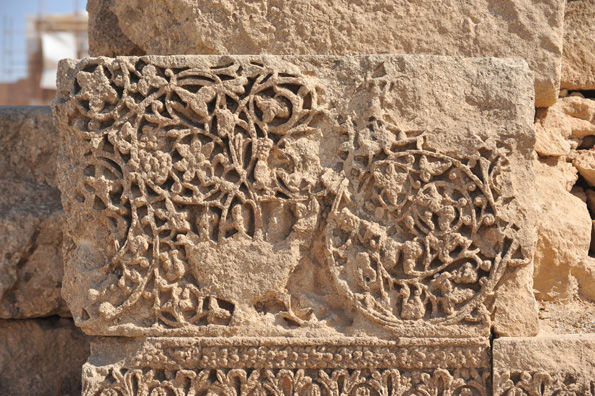Fragment Carved with Vine Scroll and a Vase, mid-8th century. Made in Jordan, Qasr al-Mshatta. Limestone, carved. Department of Antiquities, Qasr al-Mshatta Archaeological Site, Jordan
Look closely at the carved stonework from the facade of Qasr al-Mshatta, and you will spot a world of griffins, peacocks, lions, and pheasants hiding in the shade of delicately rendered grape leafs. The refinement of the representations here has captivated scholars and public alike for a century, ever since it arrived in Berlin as a gift from the Ottoman Sultan Abdulhamid to Kaiser Wilhelm I shortly before World War I.
Mshatta is located outside present-day Amman, its ruins now alongside the city's modern airport. Some bits of the monument remain in situ, including the fragments on display in Byzantium and Islam: Age of Transition (their temporary presence at the Met represents the first time away from the site since they were carved). Despite the facade's prominence as a key monument of Islamic art, a great deal of mystery surrounds Mshatta's construction. Its medieval name remains unknown, and its patron is debated. The site's dating, like many of the Umayyad qusur, or desert palaces, is controversial. Some would place it in the reign of al-Walid II between the years 743–744, toward the end of the Umayyad period, while others have argued a later construction under the Abbasids.1
Fragment Carved with Vine Scroll and a Triangle Trimmed with Bead-and-Reel Motif, mid-8th century. Made in Jordan, Qasr al-Mshatta. Limestone, carved. Department of Antiquities, Qasr al-Mshatta Archaeological Site, Jordan
Mshatta's decor is particularly interesting in that it suggests the early Muslim community was attentive to distinctions between secular and sacred space. While most of the decoration filling the zig-zag shapes along the facade's walls are populated with animated creatures entirely in keeping with secular elite residential décor, one side lacks animals of any kind. This is the qibla wall, on the side facing Mecca, along which was located the qasr's mosque. A pronounced effort at visual distinction suggests a concept of the appropriate uses of figural imagery in secular contexts, but not in sacred ones, had developed already by the eighth century.
Read More
Anna Ballian, "Country Estates, Material Culture, and the Celebration of Princely Life: Islamic Art and the Secular Domain," in Byzantium and Islam: Age of Transition, 200–208
ArchNet Digital Library: https://archnet.org/library/sites/one-site.jsp?site_id=7362
[1] These discussions are summarized in Anna Ballian, "Qasr al-Mshatta," in Byzantium and Islam: Age of Transition, 209– 210.

